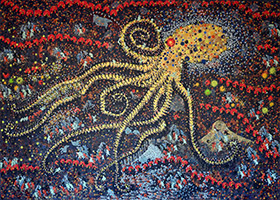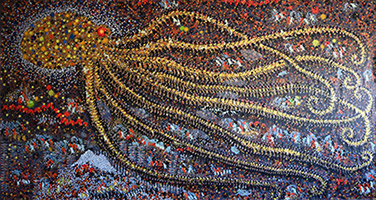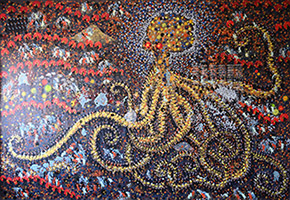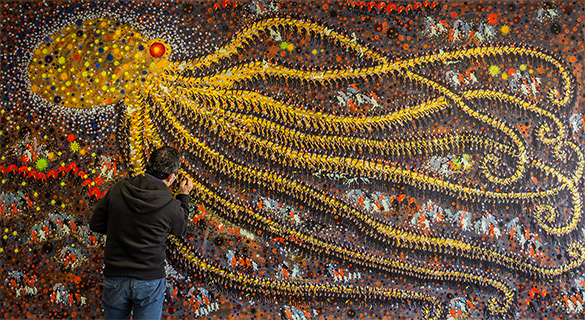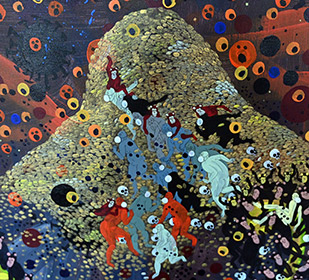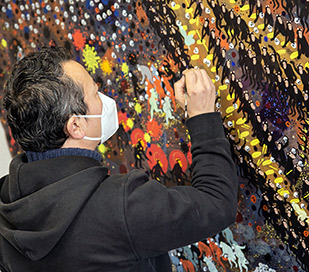However,
getting closer to the painting and connecting our little grey cells, as
a certain Hercule Poirot would say, is enough for the mask to fall and
the reality to be revealed. The puzzle then begins to fall into place,
a much darker and much less cheerful puzzle. Then, the music changes
its tonality, and something gently breaks in our hearts, like glass
cracking. Impossible to put it back together. We understand that we
should look past appearances, and that we will have to dive deeper into
these paintings to discover the truth. The details spurt out of every
corner of the paintings, forcing us to a long contemplation to find the
answers to our questions.
The sounds of drums and piano are quickly replaced by the sound of
flames. Laughter and applause are replaced by moans, cries, and pleas.
The scene changes completely: we are no longer attending a party or a
colorful carnival. After a few minutes of contemplation, we have gone
from heaven to hell. The atmosphere becomes suffocating, and our
panicked eyes fight tirelessly to find positivity, cheerfulness, and
happiness.
The blood-red eyes of the octopus cut off sharply this attempt, most
probably doomed to failure. This creature stretches out and takes a
central place in all three canvases. In The Last Supper 3,
the creature resembles a bloodthirsty monster or some Terminator,
lifeless and merciless, with only one goal: to crush and kill.
Therefore, the humans’ tears and lamentations do not worry him at all,
and his powerful tentacles are ready to seize his prey. This octopus
becomes the ideal symbol to paint the virus that has fallen upon us and
its many consequences.
For some, the
octopus is the embodiment of hellish spirits, if not hell itself. Just
like the virus, the octopus is silent, whatever the circumstances. It
is the very example of adaptation and its ability to go unnoticed is
extraordinary. This dazzling adaptation to its environment often
involves mimicry and transformation. Like a magician, the octopus
changes color according to its moods or needs by blending into the
scenery, or goes even one step further by changing its shape. Moreover,
its body being devoid of skeleton, it is very flexible. From the human
point of view, these abilities impress and terrify. It is therefore not
surprising that exactly this creature was chosen to embody both the
monstrous Kraken, the concrete form of absolute evil hidden at the
bottom of the waters, and the virus in OtGO’s paintings. Invisible and
highly contagious, the latter plunged the entire planet into chaos,
isolation, and grief. Like the octopus, the virus has adapted, giving
rise to variants that continue to appear even today. It has no smell,
no color and above all no face. And what cannot be seen has always been
feared. The unknown, whether positive or negative, is terrifying. We
have no weapons, no instructions to help us.
We have to get out of our comfort zone, learn again how to live, and
sometimes even how to survive by adapting to our new environment.
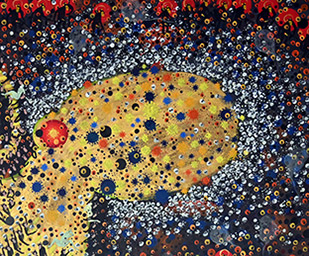
Detailed view: The Last Supper
To
emphasize the symbolic of disease, the cephalopod’s head is filled with
human skulls and viral particles. The latter are escaping, huge or in a
fine rain, until invading the whole canvas. After all, these small
stains that looked from afar like colorful lights or joyful confetti,
are in fact the representatives of this silent death.
Observed from afar, the head of the octopus itself becomes a gigantic
human skull. This element is not so surprising after all, since it is
mankind who has created or at least actively participated in the
creation of this chaos.
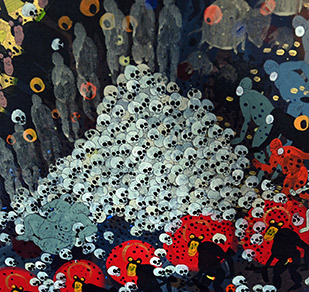 Detailed view: The Last Supper
Detailed view: The Last Supper
Human
skulls are everywhere. They lie on the ground, in piles or scattered,
sad representatives of a human life that is running out of breath. The
survivors, forced to wander in the dark, understand only too well the
fate that awaits them. Gathered together, the skulls remind us of
ancient times when, in order to preserve those still alive, the bodies
contaminated by the plague or cholera epidemic were piled up and then
burned or quickly buried.
As we continue our meticulous work of observation, the paintings reveal
to our eyes the presence of human souls. These souls, forced to leave
their bodies and their earthly existence, sadly look back at their
remains before slowly making their way to nothingness.
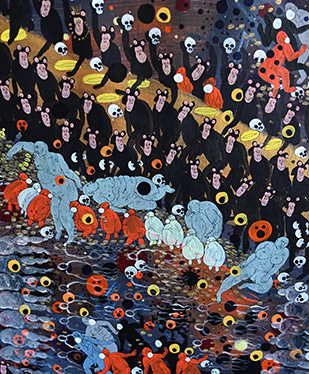 Detailed view: The Last Supper
Detailed view: The Last Supper
The
epidemic has snatched them from life without warning like lightning in
the middle of a clear and peaceful day. They no longer have faces, nor
bodies, nor names. As Ernest Hemingway rightly said, "We must get used
to it: at the most important crossroads of our lives, there are no
signs". Only their silhouettes, almost transparent, remain for a while.
Are they Men or Women? One could not say it. In the face of
nothingness, nothing of all this subsists.
The
few humans still alive are not in any more luck. Some of them are
nonetheless trying to flee while protecting their bodies with their
hands. A mother, her child in her arms, is fighting to survive. Other
women, who appear to be pregnant, are trying to save the life that is
growing inside them. Unfortunately, despite the felt discomfort,
despite the complaints of the tortured, we cannot save them. Only our
eyes can brush them.
The presence of orange brushstrokes on the black background of the
canvases sends us back to the flames and the extreme heat. Very
quickly, the feeling of being in an oven or a fireplace settles in us.
No exit door on the horizon, not the slightest escape either.
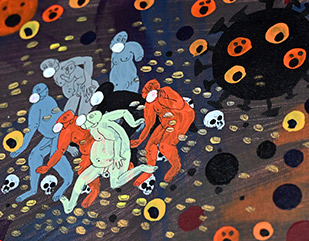 Detailed view: The Last Supper
Detailed view: The Last Supper
Yet,
among the human beings in the paintings, some seem to suffer less than
others. Much taller and heavier, in an almost supernatural way, they
don't seem to care about what is happening around them. Sitting, lying
or almost gravitating, their look expresses complete indifference, if
not even contempt towards the fate reserved to their peers who are
shouting, agitating, and finally dying. Their chubby bodies, sometimes
pushed to an extreme obesity, refer to the series of paintings of
Lucian Freud and resound as a tribute to the work of the artist.
Incidentally, the pose of certain characters is easily recognizable and
refers directly to the paintings of Freud: "Naked man, back view"
(1991-1992), "Naked portrait with reflection" (1980) or "Benefits
Supervisor Sleeping II" (1995). The bodies of these people represent
greed, cupidity, the thirst for power and money. They need more, always
more, because only that counts, only that obsesses them. Hence the fact
that they seem elsewhere, completely out of this world. Even though
they are alive, their humanity is lost. They are nothing more than
empty shells, insensitive and isolated beings.
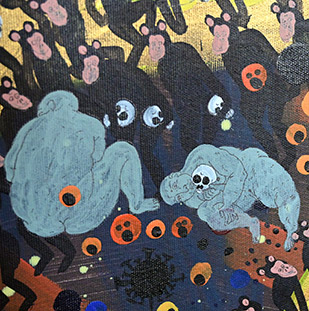 Detailed view: The Last Supper
Detailed view: The Last Supper
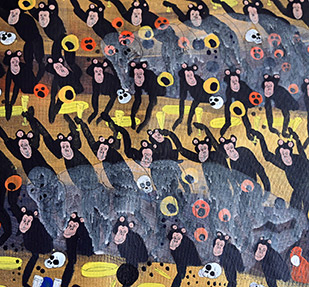 Detailed view: The Last Supper
Detailed view: The Last Supper
By
dint of excess, the human race has pushed its own existence to
destruction and suffering. This can be seen very clearly in OtGO's
paintings. Only the humans are suffering from the situation. The
monkeys are feasting. The presence of forks, plates and champagne
flutes clearly indicates that this situation, terrible for mankind, is
a real blessing for the animals.
The octopus's tentacles become tables, and nothing disturbs their good
mood. They are raising their glasses, as if toasting, while taunting
the frightened and weakened humans. The contrast created by OtGO
between the two situations is striking and pushes the spectators that
we are to look reality in the face.
We then become witnesses of our collective suicide, for our eyes have
brushed the canvases. Some bipeds, crowned like kings, seem to lead
this little party. When some see their cup rising, others see their
head falling.
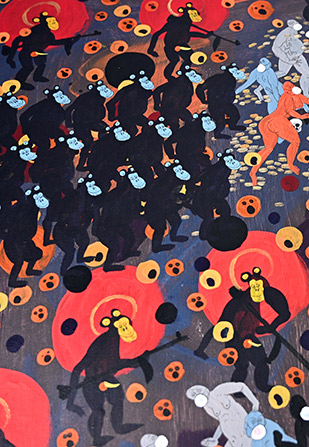 Detailed view: The Last Supper
Detailed view: The Last Supper
More
cruel than the party primates, huge gorillas make this scene even more
violent by transforming it into a place of war and desolation: larger
than the others, with oversized genitals and rifles in their hands,
they are scrutinizing the few humans still alive.
The appearance of the latter, completely naked and left to their fate,
reminds us of the horrors that humanity has inflicted on itself and on
animal life throughout History. Painted on a red background, halo above
their heads, the torturers seem to put on suits of sanctity while
punishing criminal souls.
Just like in Pierre de Marivaux's Slave Island (L'île des Esclaves),
the masters have become the slaves and the slaves, the new masters. But
unlike Marivaux's book, no forgiveness is possible. Impulses and
violence have prevailed over reason and mercy.
